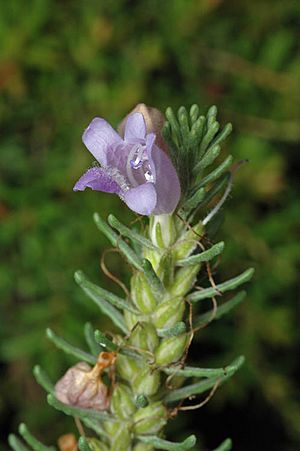Eremophila caerulea facts for kids
Quick facts for kids Spotted eremophila |
|
|---|---|
 |
|
| Scientific classification | |
| Genus: |
Eremophila (plant)
|
| Species: |
caerulea
|
The spotted eremophila (its scientific name is Eremophila caerulea) is a type of flowering plant. It belongs to the figwort family, called Scrophulariaceae. This plant is special because it grows naturally only in the southwest part of Western Australia. It's a small, bushy shrub with narrow, bumpy leaves and beautiful blue or purple flowers.
Contents
What the Spotted Eremophila Looks Like
The spotted eremophila is a dense shrub with many tangled branches. It has a strong smell, a bit like camphor. This plant usually grows to be about 0.3–0.6 m (1–2 ft) tall. It can also spread out up to 0.7 m (2 ft) wide.
Its leaves grow in groups of 3 or 4, like a whorl. They are usually 4–10 mm (0.2–0.4 in) long and about 1 mm (0.04 in) wide. The leaves are long and thin, almost round if you cut them in half. They also have many small, raised bumps on their surface.
Spotted Eremophila Flowers
The flowers grow one by one where the leaves meet the stem. They don't have a stalk. There are 5 green, thin, or spear-shaped sepals, which are like small leaves that protect the flower bud. These sepals are 3–5.5 mm (0.1–0.2 in) long and feel hairy.
The petals are 9–14 mm (0.4–0.6 in) long and are joined together at the bottom to form a tube shape. The outside of this tube is blue to purple. The inside is white with purple spots. There are also some hairs on the outside of the tube. The inside of the tube is full of thin, spidery hairs, and the lower petal also has hairs.
There are 4 stamens, which are the parts of the flower that make pollen. Two of these stamens stick out a little past the petals. The other two stay inside the petal tube. This plant mostly flowers from September to November. After flowering, it produces dry, oval or almost round fruits that are 2.5–4 mm (0.1–0.2 in) long.
How the Plant Got Its Name
The spotted eremophila was first officially described in 1899 by Spencer Moore. He called it Pholidia caerulea. Later, in 1904, Ludwig Diels and Ernst Georg Pritzel changed its name to Eremophila caerulea.
The second part of its scientific name, caerulea, is a Latin word. It means "dark blue," which describes the color of its petals.
Spotted Eremophila Subspecies
There are two slightly different types, or subspecies, of this plant:
- E. caerulea (S.Moore) Diels subsp. caerulea: This type has leaves with only a few hairs and spear-shaped sepals. It grows between Kalgoorlie, Norseman, and Bruce Rock.
- E. caerulea subsp. merrallii Chinnock : This type is also known as Bruce Rock eremophila. It has very hairy leaves and thin, straight sepals. You can find it between the Hunt Range, Southern Cross, and Bruce Rock.
The name merrallii was chosen to honor Edwin Merrall. He was a gold prospector who was the first person to collect this plant.
Where the Plant Grows
The spotted eremophila grows west of Kalgoorlie in a part of Western Australia called the Coolgardie region. It likes to grow in red sand or stony clay. You can find it in woodland areas or in places with mallee trees, often on gently rolling plains.
Protecting the Spotted Eremophila
The Eremophila caerulea subsp. caerulea is considered "not threatened." This means there are enough of these plants, and they are not in danger.
However, the Eremophila caerulea subsp. merrallii is listed as "Priority Four" by the Western Australian Government's Department of Parks and Wildlife. This means it is rare, but it's not currently in immediate danger. They are keeping an eye on it.
Growing Spotted Eremophila in Gardens
This plant is great for gardens! Its compact shape and unique leaves make it a popular choice. It's also easy to grow new plants from cuttings, though it might take up to 3 months for the cuttings to start growing roots, even in warm weather.
The spotted eremophila can grow in most types of soil, but it might grow slower in clay soil. It can handle full sun or partial shade. It rarely needs to be trimmed and can even survive very cold frosts.

